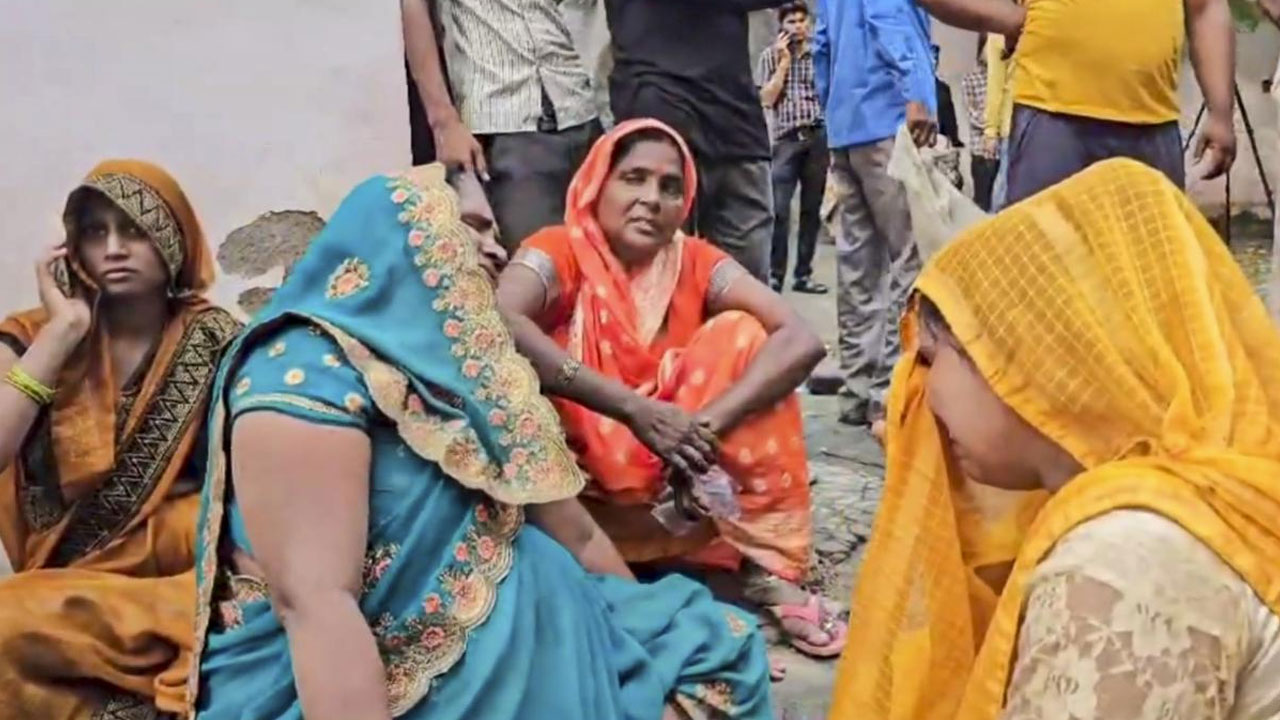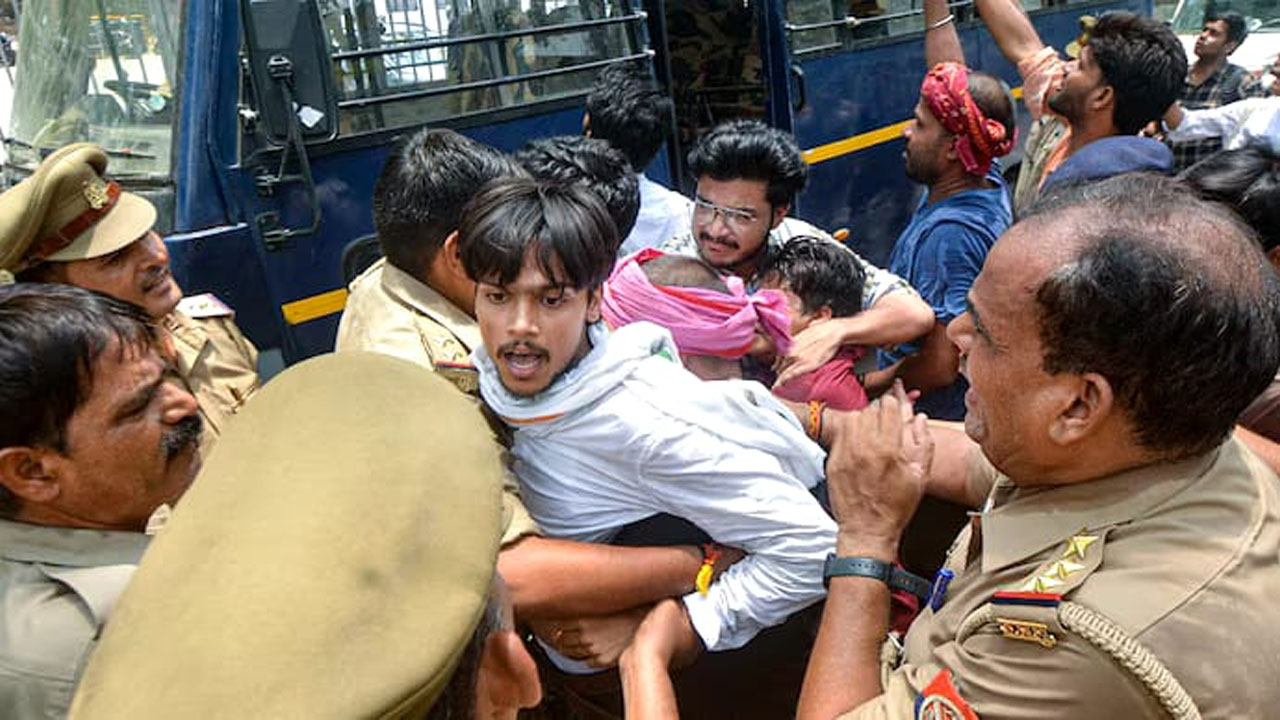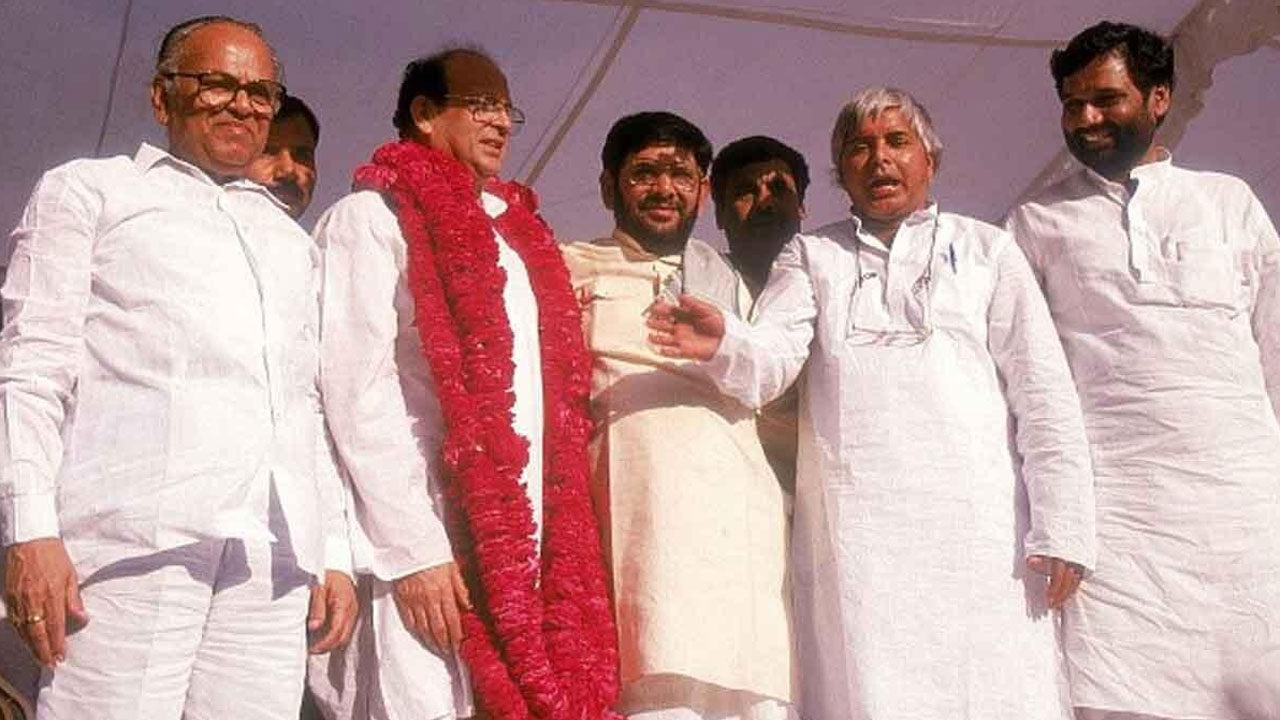The caste system can reveal a lot about the ills plaguing Indian society. As long as you talk about or critique the origin of caste and its culture, there seems to be no unease in society. But as soon as you identify the politics and the economics of the caste system, the discussion veers to the sustenance of Indian society, especially Hindu society. Modern democratic values are cited to argue that everyone should have equal rights, that there should be no casteism and that open competition is imperative for the progress of India. Whenever the political and economic system of the country was linked to the caste system, the flag-bearers of religion never refrained from singing paeans to the Sanatan tradition and its heroes.
The situation has changed over the past few decades. The rise of the Bharatiya Janata Party (BJP) has brought about a change in the perspective concerning keeping the caste system intact. Strategists of the party – often referred to as its Chanakya – deftly used the Mandal-Kamandal binary to its advantage. They used Kamandal as a fulcrum and adopted and stuck to the policy of turning the Mandal commission’s report into a vote-getter. The nomenclature used was “social engineering”. This mainly involved driving a wedge between the different caste groups with respect to the Mandal Commission recommendations and using it to increase numbers in the legislative bodies. The policy adhered to was to further divide backward castes into backward and extremely backward castes and pit them against each other. Amid all this, improving the process of granting reservation in education and jobs and political representation to the historically marginalized ceased to become a priority. Thus the question of a caste census both in the states and nationally began to be bypassed – until the Nitish Kumar-led Bihar government went ahead and conducted a caste survey in the state, presenting the social, political and economic status of different castes based on their populations.
The Bihar government’s report shattered many carefully constructed myths on reservation. It also forced other states, where commissions had been constituted for conducting caste surveys or were in the process of being constituted, to step up a gear.
But the situation is very different in Uttar Pradesh, where the Yogi Adityanath-led government is in its second term. Following the setting up of the Rohini Commission, in May 2018, a commission under the chairmanship of retired High Court Justice Raghvendra Kumar was constituted for rationalizing the reservation granted to the Backward Classes. The commission submitted its report to the state government in October 2018 but the report was not tabled in the assembly. The Yogi government did try to implement reservations in elections to Nagar and Gram Panchayats but the proposal was shot down by the court saying there was no basis to justify the measure.
Similarly, an attempt was made to include new castes among the Scheduled Castes. But that too was barred, and predictably so, on the ground that it would encroach on the jurisdiction of the central government. The track record and the attitude of the former Samajwadi Party government on this issue was no better. It also used government orders to implement its decisions on related issues, whereas the need was for conducting a caste census to get a real picture of society.

In Uttar Pradesh, the issues related to reservations and OBCs are quite complex and not easy to disentangle. The implementation of the Mandal Commission report had caused a tumult in Indian politics. The discussions and debates around it may have failed to sensitize society to the needs of the OBCs but these did promote retrogressive ideas. An impression was sought to be created that only certain dominant OBC castes, especially the Yadavs and the Kurmis, benefited from reservation. This argument was extended to even the SCs, singling out Jatavs as the main beneficiaries of reservations.
This has to do with how the political parties of Uttar Pradesh have been shaped. In Uttar Pradesh politics, Chaudhary Charan Singh was seen as the leader of the Jats, the Samajwadi Party as a party of the Yadavs and the Bahujan Samaj Party as a representative of the Jatavs. This situation was similar in Bihar, Maharashtra and Karnataka. This discourse led to the BJP-led central government constituting the Rohini Commission in October 2017 with the mandate for subdividing the 27 per cent OBC quota between different castes. It was required to categorize around 3,000 OBC castes. After seeking – and getting – many extensions, the commission submitted its report to the President on 31 July 2023.
According to the National Sample Survey (NSS) data published in 2007, OBCs formed 40.94 per cent of the total population of the country; 19.59 per cent Indians were SCs; and 8.63 per cent were STs. In its 2001 report, a committee headed by Hukum Singh, then BJP legislator, found that OBCs were 50 per cent of the population of Uttar Pradesh. It estimated the Yadav were 19.40 per cent and the Kurmi-Patel were 7.4 per cent. Nishad, Kewat and Mallah formed 4.3 per cent of the state population; Rajbhar, 2.4 per cent; Lodhi, 4.8 per cent; and Jat, 3 per cent. The committee had considered only 79 identified castes. While in 2001, the total population of Uttar Pradesh was 16.61 crore, the Hukum Singh committee had looked into the caste composition of only 7.56 crore people.
In Uttar Pradesh, the BJP focused its politics on the Extremely Backward Classes (EBCs) as it worked on caste equations to maximize votes. Linking Hindutvavadi sanskritisation to the question of political representation, it projected the SP and the BSP as narrow, casteist family fiefdoms, which wanted to grab power at any cost and presented itself as a benefactor of the Backwards, drawing the EBCs into its camp. This is the context in which the Justice Raghvendra Kumar Commission was set up. This commission submitted its 400-page report to the government in October 2018. It is believed that the commission has divided the OBCs into three categories – Backward, More Backward and Most Backward. So far, the Adityanath Government has not tabled the commission’s report in the assembly. The report is hence not in the public domain. Yet, newspapers came out with many formulae supposedly suggested by the commission. It was also claimed that a handful of castes were taking advantage of reservations.
Uttar Pradesh saw many other political experiments vis-à-vis the OBCs. There was an attempt to include 17 EBC castes in Scheduled Castes. First, Akhilesh Yadav tried to do this and then Yogi Adityanath followed suit. The castes which were sought to be moved from the OBC to the SC category included Kahar, Kashyap, Kewat, Mallah, Nishad, Kumhar/Prajapati, Dheevar, Bind, Bhar/Rajbhar, Dheeman, Batham, Turha, Godia, Manjhi and Machhuara.
Instead of increasing reservation quotas, castes were set against each other within the existing limited quotas. This politics came to the fore, during the local body elections, in which some bodies were declared reserved for the OBCs without any study or analysis.
Both these decisions were annulled by the High Court. About the former, the court said that only the Centre was empowered to include new castes among the Scheduled Castes while it questioned the propriety of introducing reservations in the civic bodies without any study to back such a move. In January this year, a commission was set up under the chairmanship of Justice Ramavtar Singh to study the feasibility of implementing OBC reservations in elections to urban civic bodies and was asked to submit its report within six months. The commission toured all the 72 districts and picked many holes in the earlier notification reserving urban bodies for OBCs. The report said that 37 per cent of the urban residents in Uttar Pradesh were OBCs, 49 per cent (including Muslims) belonged to the General category and 14 per cent were SCs. The commission also found that the OBCs formed a bigger part of the population in small towns than in the bigger cities.
The commission found that OBCs formed 51 per cent of the population of Maharajganj town but the local constituency was reserved for SCs. This was true of Bijnor and Hardoi, too. The share of the OBCs in the urban population was 42.19 per cent in eastern Uttar Pradesh (Purvanchal) and 37.53 per cent in western Uttar Pradesh. The corresponding figure for central Uttar Pradesh was 27.55 per cent. In the civic body elections held in April-May 2023, 27 per cent reservation was granted to the OBCs. Thus the discrepancies in the implementation of reservations and the condition of the OBCs identified by the reports of the two commissions set up by Yogi government, and the matter of other benefits accruing from political representation and reservations haven’t received requisite attention. Nor has the question of representation in proportion to population been discussed.
BJP’s strategy in UP
The BJP’s political strategy has changed swiftly since the implementation of the Mandal Commission report. The Indian elite class, which is almost entirely composed of the Savarna castes, carefully wove a myth that development could only be brought about by adopting neoliberal economic policies. This class was feeling so insecure that it wanted to strengthen and stabilize its economic status by dismantling the public sector and handing over the assets of the country to capitalists. At the same time, it sought to deal with the ferment and the unrest triggered by the reservation regime by laying stress on the Hindutva concept of society as an extended family, in which the head of the family remains in charge, while unveiling some programmes for providing relief to its weaker members. This was when the BJP started working among the OBCs and Dalits by forging alliances with parties which had already been representing these communities.
In Uttar Pradesh, the BSP had almost uprooted the Congress. But a foothold in OBC politics was still eluding the BJP. The BJP operated at two levels. One was to create the impression that it wanted the EBCs to become a part of the SCs. However, its lack of seriousness was more than apparent. For instance, the Yogi government unilaterally announced the inclusion of 17 EBCs among the SCs, only to hit the High Court roadblock. Had the Yogi government been honest, it could have forwarded its recommendations to the Narendra Modi government at the Centre. Evidently, this was only a vote-catcher exercise. Secondly, it constituted many commissions to project itself as a well-wisher of the EBCs. Over the past 25 years, BJP governments have constituted three commissions on issues related to the OBCs. Their reports have either been not discussed or rejected. As far as the most recent of these reports is concerned, only the part related to reservations was implemented and the rest was ignored.
As part of its strategy, the BJP used the Muslims as a bogey to polarize society. The matter of Pasmanda Muslims thus remained in the background.
As 2024 General Elections draws closer, the BJP leadership’s unease with regard to Uttar Pradesh is becoming increasingly palpable. The Bihar caste survey report has knocked the bottom off its stand on dominant OBC castes. Moreover, the socio-economic status of the OBCs, as evidenced by the survey data, has turned out to be very different than what it had anticipated. The report shows that the caste divides are so real that it would be meaningless to talk about a united Hindu family.
To counter the Bihar caste survey effect, the BJP is carrying out a multipronged campaign in Uttar Pradesh. Dr Ambedkar Samman and Dalit Jodo Mahabihyan are going on on a grand scale. Conventions are being held in various districts involving Dalits from all walks of life including intellectuals, workers and students. Similarly, to woo the Pasmanda Muslims, a campaign has been launched under which the achievements of the Modi government will be showcased in 10,000 shrines across the state and Muslims are being encouraged to join the BJP. Many mega programmes to this end have already been held and this campaign is still going on. But the BJP is most anxious about shoring up support among the OBCs. While canvassing for the BJP in elections in other states, Modi flaunted his OBC identity at least on two different occasions. But Yogi Adityanath can’t do it, not only because of his caste but also because in Uttar Pradesh, he is projecting himself as a protector of the Sanatan Dharma and has been talking about his leading role in the construction of the Ram Temple in Ayodhya.
The Bihar caste survey has not only brought to the fore the condition of the EBCs but also the numbers and the status of the Pasmanda Muslims. The Bihar Assembly has unanimously passed a resolution raising the reservations for the Dalitbahujan from the Supreme Court imposed 50 per cent ceiling to 65 per cent. Clearly, the BJP will now find pursuing its politics of exploiting the internal contradictions in the OBC camp increasingly difficult. The OBC parties with whom the BJP has been collaborating now have just one demand – caste census – and they are also rethinking their stand on the entire reservation regime.
In Uttar Pradesh, OBC politics has been relentlessly pushed to the margins over the past three decades. In this respect, it is different from other states. The BJP saw OBC politics only as a field from which it could harvest a rich yield of votes. It used Muslims for communal polarization and constructed the Yadav narrative to polarize the OBCs. If caste populations are counted in Uttar Pradesh or if the earlier reports are made public, such an exercise will not only show these numbers or a change in the proportion of the OBCs but also demolish many myths. The BJP is working hard to ensure that this does not happen and, to obviate the impending crisis, has embarked on a series of mega campaigns. The party is preparing to hold a mega conclave of OBCs in the first week of January to resolve issues related to reservation and caste census. At present, the BJP’s central leadership is avoiding discussions on caste census.
Caste census: Those in favour and against
When the second and final instalment of the Bihar caste survey report was released, the BSP leadership was busy campaigning in Rajasthan and the SP leadership in Madhya Pradesh. Akhilesh Yadav and Mayawati have more complaints against the Congress than the BJP. They are rather upset that the Congress is backing the demand for caste census. Recently, Akhilesh issued a statement saying that the Congress wants society X-rayed but why it is not seeking an MRI. The Congress party has been out of power in Uttar Pradesh for 30 years and the BJP, SP and BSP have been in power over that period. Then, what is the point in placing the caste census ball in Congress’s court? The BJP is working on building an understanding with OBC parties other than these two and is campaigning intensively among the Muslims and the Dalits. Needless to say, it wants to persuade them to toe its line on caste census. It is imperative that the BSP and SP leadership actively engage with this issue and instead of attacking the Congress, which has been demanding a caste census, pave the wave for a wider opposition unity.
A pertinent question is, what is to be gained from a caste census? Will it only improve the reservation regime and not do anything else? It is not a mere coincidence that the decennial census has been stalled in India for a long time and even the entire data of the last census has not been made public. The National Sample Survey Office (NSSO) has also stopped conducting surveys. These reports don’t help the landless secure land or the unemployed get a job. They only tell us about the conditions prevalent in our society. They bring to light where the different classes stand. They also bring to light the social, cultural and economic structure of the caste system, the politics of which is also deployed to maintain the status quo. Caste census can bring to light the truth about Indian society, which has long been kept under wraps. We have to realize that caste is not only a cultural construct. It is also a social institution with its own economic structure and politics. It needs to be understood along with its context and not be just acquainted with.
(Translation from the original Hindi by Amrish Herdenia)
Forward Press also publishes books on Bahujan issues. Forward Press Books sheds light on the widespread problems as well as the finer aspects of Bahujan (Dalit, OBC, Adivasi, Nomadic, Pasmanda) society, culture, literature and politics. Contact us for a list of FP Books’ titles and to order. Mobile: +917827427311, Email: info@forwardmagazine.in)





